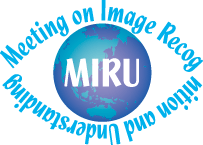|
■ 特別講演1 7月20日(月) 9:40~(予定)
鳥脇 純一郎 先生

中京大学 生命システム工学部 教授
略歴
講演タイトル:
濃淡画像処理または医用画像処理の研究45年の記録より
講演概要:
研究の開始を修士課程(大学院前期課程)入学(1964年)とすると、大体45年になる。
この間の研究テーマは、結果的には濃淡画像処理、and/or 医用画像処理と言えようか。
しかし、これは実は見る方向によって変わり、パターン認識であったり、画像処理アルゴリズムであったりする。
それに応じて違った側面が見えてくる。
本講演では取り組んだテーマを大まかに時代順に紹介し、それぞれの分岐点でどんなことを考えてその方向を選んだか、あるいは研究の途中でどういう風に考えたか、などについて記憶するところに基づいて紹介してみたい。
この間を大まかに10年間隔くらいで区切って印象に残るテーマや出来事をあげてみよう。
Ⅰ-1 助走(迷走?)の時代(1964~1966):
印刷文字認識、心電図の認識、胸部X線写真との出会い。
入力装置の開発、 コンピュータとの出会い 、エム・イー(医用電子/生体工学)との出会い
Ⅰ-2 胸部X線写真の認識-揺籃期:(1967~70)
今で言うCAD(computer-aided diagnosis)の開始。X線像CAD問題の提唱→認知? X線写真のCADの最初、アルゴリズムの研究中心へ。大型計算機センター中心へ。濃淡画像処理スタート
Ⅱ 胸部X線写真の認識-システム化とアルゴリズムの(前期)発展期(1971~80)
ディジタル幾何学的手法、AISCR-V2→AISCR-V3、各種フィルタ、2値画像処理アルゴリズム(細線化など)。
CTの出現、1st IJCPR、1st日米セミナ
Ⅲ CTと3次元画像への移行期、アルゴリズムの(後期)発展期(1981~1990)
CG開始、CT画像処理揺籃期→3次元濃淡画像処理の登場、3次元ディジ タル幾何学、CTの臨床応用普及、
AISCRの終焉
Ⅳ 認識+可視化+映像経由の人体操作の時代(1991~2003)
CGの時代(質感表現など)、CASの登場とCAS/CADM共存の時代へ、VES提案、VRの登場、仮想化人体の提唱
Ⅴ 新しい舞台へ (2003~)
石刻絵画の自動分類
著作の見直し
講演では、これらの具体例とそれぞれの時点で考えていたこと、あるいは、後で見て考えが至らなかったこと、などを話してみたい。
■ 特別講演2 7月21日(火) 9:00~(予定)
Dr. Marc Pollefeys

Full Professor,
Department of Computer Science,
ETH Zurich
Associate Professor,
Department of Computer Science,
University of North Carolina at Chapel Hill
Talk title:
Challenges in wide-area structure-from-motion
Abstract:
In this talk, I will present work on wide-area structure-from-motion (SfM) such as city-wide 3D reconstructions from millions of video frames.
While in recent years a lot of progress has been made in the area of SfM and multi-view stereo reconstruction, wide-area 3D reconstructions and mapping lead to interesting new research challenges.
It is for example important to use algorithms that are efficient as typically millions of frames have to be processed.
In this context we will present algorithms which exploit the tremendous computational power of recent graphic processing units (GPU) to achieve real-time performance.
Another challenge consists of avoiding unbounded accumulation of errors.
For this it is important to close loops when the camera path crosses itself (e.g. at street interesections).
We introduce viewpoint-invariant-patches (VIP) to enable robust and efficient matching over widely varying viewpoints (e.g. orthogonal crossings).
Our approach is illustrated with 3D reconstructions of Chapel Hill.
|
|


